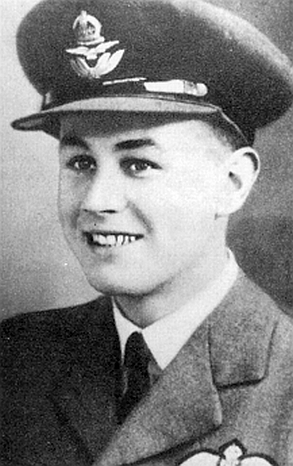Barton, Cyril Joe
- Date of birth:
- June 5th, 1921 (Elveden/Suffolk, Great Britain)
- Date of death:
- March 31st, 1944 (Ryhope/Durham, Great Britain)
- Buried on:
- Commonwealth War Graves Kingston upon Thames
Plot: C. Grave: 6700. - Service number:
- 168669
- Nationality:
- British
Biography
Cyril Barton was brought up in New Malden, Surrey, where he had attended Beverley Boys School and Kingston College. He volunteered for aircrew duties and joined the Royal Air Force Volunteer Reserve, RAFVR on 16 April 1941, qualifying as a Sergeant Pilot 10 November 1942. He then trained at No. 1663 Heavy Conversion Unit at Rufforth, Yorkshire. On 5 September 1943, Barton and his crew joined no.78 squadron, and Barton was commissioned as a Pilot Officer three weeks later. Undertaking their first operational sortie against Montlucon, Barton completed 9 sorties with No.78 squadron until 15 January 1944, and was then posted to No.578 Squadron. Their second sortie with the new squadron was to Stuttgart in Halifax LK797. Barton was promoted to Flying Officer on March 26th. By 30 March 1944, they had completed 6 sorties in LK797 - which the crew had named "Excalibur".
In a letter to his mother, to be opened in the event of his death, he wrote: ‘I hope you never receive this, but I quite expect you will.
I know what ops over Germany means and I have no illusions about it. By my own calculations, the average life of a crew is 20 ops . . .’
He was killed on his 19th bombing operation and posthumously was rewarded the Victoria Cross.
Do you have more information about this person? Inform us!
- Period:
- Second World War (1939-1945)
- Rank:
- Pilot Officer
- Unit:
- No. 578 Squadron, Royal Air Force
- Awarded on:
- December 5th, 1944
"1.On the night of 30th March 1944, Pilot Officer Barton was captain and pilot of a Halifax aircraft of 578 Squadron detailed to attack Nuremberg. When some 70 miles short of the target, the aircraft was attacked by a Junkers 88. The first burst of fire from the enemy aircraft made the intercommunication system useless. One engine was damaged when a Messerschmitt 210 joined the fight. The bomber's machine guns were unable to return the fire.
2.Fighters continued to attack the aircraft as it approached the target area and, in the confusion caused by the failure of the intercommunication system at the height of battle, a signal was misinterpreted and the navigator, air bomber and wireless operator left the aircraft by parachute.
3.Pilot Officer Barton faced a situation of dire peril. His aircraft was damaged, his navigational team had gone, and he could not communicate with the remainder of the crew. If he continued his mission, he would be at the mercy of hostile fighters when silhouetted against the fires in the target area and if he survived, he would have to make a 4½ hours journey home on three engines across heavily defended territory. Determined to press home his attack at all costs, he flew on and, reaching the target, released the bombs himself.
4. As Pilot Officer Barton turned for home the propeller of the damaged engine, which was vibrating badly, flew off. It was discovered that two of the petrol tanks had suffered damage and were leaking. Pilot Officer Barton held to his course and, without navigational aids and in spite of strong head winds, successfully avoided the most dangerous defence areas on his route. Eventually he crossed the English coast only 90 miles north of his base.
5. By this time the petrol supply was nearly exhausted. Before a suitable landing place could be found, the port engines stopped. The aircraft was now too low to be abandoned successfully. Pilot Officer Barton therefore ordered the three remaining members of his crew to take up their crash positions. Then, with only one engine working, he made a gallant attempt to land clear of the houses over which he was flying. The aircraft finally crashed and Pilot Officer Barton lost his life, but his three comrades survived.
6.Pilot Officer Barton had previously taken part in 4 attacks on Berlin and 14 other operational missions. On one of these, two members of his crew were wounded during a determined effort to locate the target despite appalling weather conditions. In gallantly completing his last mission in the face of almost impossible odds, this officer displayed unsurpassed courage and devotion to duty. "
Pilot Officer Barton’s Victoria Cross is publicly displayed at the Royal Air Force Museum in Hendon, England.
Cyril Joe Barton is Buried at the Bonner Hill Road Cemetery, Kingston-upon-Thames, Great Britain.
- Period:
- Second World War (1939-1945)
- Rank:
- Flight Sergeant
- Awarded on:
- November 10th, 1942
Sources
- Photo 1: Find a Grave Homepage
- Photo: Find a Grave Homepage
- - Victoria Cross Reference
- The Register of the Victoria Cross - published by This Engeland 1997 - ISBN 0906324270
- Special thanks to Iain Stewart from The History of the Victoria Cross
- The Victoria Cross.net
- Aircrew Remembrance Society





